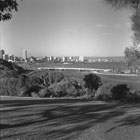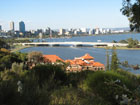Describing the Swan River



The Swan River links suburbs and regions, the hills and the sea and has created and allowed the growth of Perth. It has been a food source, a transport route, a sewer, a rubbish dump but also a place for reflection and recreation, a spiritual place. It has been a great leveling force in society allowing rich and poor, male and female, Aboriginal and European to live on its shores, to walk its banks or to enjoy its waters for food, for personal contemplation or for recreation.
Rivers are an integral part of human landscapes both real and mythical. The successful management of rivers and water in general has often defined the success of a civilization and a culture. No one would deny the importance of rivers, yet despite this, rivers have generally been seen as the backdrop to history, rather than a vital and living part of that history.
In 2004 the Swan River was awarded the status of Western Australia’s first heritage icon. This award recognized the River‘s immense cultural, recreational and environmental significance to the people of the State, both Indigenous and non Indigenous. It is important to understand the past, to know what has occurred and why, in order to contribute to planning for the future and to ensure that this icon is preserved and restored for future generations.
Page last updated: Tuesday 23 November 2010 by Nick Cowie Asset ID 12716
Editors for this page nick 2nd account
login


